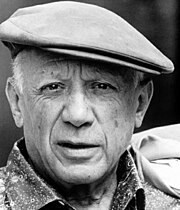Pablo Picasso

Pablo Diego José Francisco de Paula Juan Nepomuceno María de los Remedios Cipriano de la Santísima Trinidad Martyr Patricio Clito Ruiz y Picasso (October 25, 1881 – April 8, 1973) was a Spanish painter, draughtsman, and sculptor. As one of the most recognized figures in twentieth-century art, he is best known for co-founding the Cubist movement and for the wide variety of styles embodied in his work. Among his most famous works are the proto-Cubist Les Demoiselles d'Avignon (1907) and his depiction of the German bombing of Guernica during the Spanish Civil War, Guernica (1937).
Personal life
After studying art in Madrid, Picasso made his first trip to Paris in 1900, then the art capital of Europe. There, he met his first Parisian friend, the journalist and poet Max Jacob, who helped Picasso learn the language and its literature. Soon they shared an apartment; Max slept at night while Picasso slept during the day and worked at night. These were times of severe poverty, cold, and desperation. Much of his work had to be burned to keep the small room warm. In Madrid in 1901, Picasso and his anarchist friend Francisco de Asís Soler founded the magazine Arte Joven (Young Art), which published five issues. Soler solicited articles and Picasso illustrated the journal, mostly contributing grim cartoons depicting and sympathizing with the state of the poor. From that day, he started to sign his work simply Picasso, while before he had signed Pablo Ruiz y Picasso.
In the early twentieth century, Picasso divided his time between Barcelona and Paris. In 1904, in the middle of a storm, he met Fernande Olivier, a Bohemian artist who became his mistress.[5] Olivier appears in many of his Rose period paintings. After acquiring fame and some fortune, Picasso left Olivier for Marcelle Humbert, whom he called Eva. Picasso included declarations of his love for Eva in many Cubist works.
In Paris, Picasso entertained a distinguished coterie of friends in the Montmartre and Montparnasse quarters, including André Breton, poet Guillaume Apollinaire, writer Alfred Jarry, and Gertrude Stein. Apollinaire was arrested on suspicion of stealing the Mona Lisa from the Louvre in 1911. Apollonaire pointed to his friend Picasso, who was also brought in for questioning, but both were later exonerated.[6]
Portrait of Igor Stravinsky, c. 1920He maintained a number of mistresses in addition to his wife or primary partner. Picasso was married twice and had four children by three women. In the summer of 1918, Picasso married Olga Khokhlova, a ballerina with Sergei Diaghilev’s troupe, for whom Picasso was designing a ballet, Parade, in Rome; and they spent their honeymoon in the villa near Biarritz of the glamorous Chilean art patron Eugenia Errázuriz. Khokhlova introduced Picasso to high society, formal dinner parties, and all the social niceties attendant on the life of the rich in 1920s Paris. The two had a son, Paulo, who would grow up to be a dissolute motorcycle racer and chauffeur to his father. Khokhlova’s insistence on social propriety clashed with Picasso’s bohemian tendencies and the two lived in a state of constant conflict. During the same period that Picasso collaborated with Diaghilev’s troup, he and Igor Stravinsky collaborated on Pulcinella in 1920. Picasso took the opportunity to make several sketches of the composer. In 1927 Picasso met 17 year old Marie-Thérèse Walter and began a secret affair with her. Picasso’s marriage to Khokhlova soon ended in separation rather than divorce, as French law required an even division of property in the case of divorce, and Picasso did not want Khokhlova to have half his wealth. The two remained legally married until Khokhlova’s death in 1955. Picasso carried on a long-standing affair with Marie-Thérèse Walter and fathered a daughter, Maia, with her. Marie-Thérèse lived in the vain hope that Picasso would one day marry her, and hanged herself four years after Picasso’s death.
Dora Maar au Chat, 1941The photographer and painter Dora Maar was also a constant companion and lover of Picasso. The two were closest in the late 1930s and early 1940s and it was Maar who documented the painting of Guernica.
During the Second World War, Picasso remained in Paris while the Germans occupied the city. Picasso’s artistic style did not fit the Nazi views of art, so he was not able to show his works during this time. Retreating to his studio, he continued to paint all the while. Although the Germans outlawed bronze casting in Paris, Picasso continued regardless, using bronze smuggled to him by the French resistance.
After the liberation of Paris in 1944, Picasso began to keep company with a young art student, Françoise Gilot. The two eventually became lovers, and had two children together, Claude and Paloma. Unique among Picasso’s women, Gilot left Picasso in 1953, allegedly because of abusive treatment and infidelities. This came as a severe blow to Picasso.
He went through a difficult period after Gilot’s departure, coming to terms with his advancing age and his perception that, now in his 70s, he was no longer attractive, but rather grotesque to young women. A number of ink drawings from this period explore this theme of the hideous old dwarf as buffoonish counterpoint to the beautiful young girl, including several from a six-week affair with Geneviève Laporte, who in June 2005 auctioned off the drawings Picasso made of her.
Picasso was not long in finding another lover, Jacqueline Roque. She worked at the Madoura Pottery in Vallauris on the French Riviera, where Picasso made and painted ceramics. The two remained together for the rest of Picasso’s life, marrying in 1961. Their marriage was also the means of one last act of revenge against Gilot. Gilot had been seeking a legal means to legitimize her children with Picasso, Claude and Paloma. With Picasso’s encouragement, she had arranged to divorce her then husband, Luc Simon, and marry Picasso to secure her children’s rights. Picasso then secretly married Roque after Gilot had filed for divorce in order to exact his revenge for her leaving him.
Picasso had constructed a huge gothic structure and could afford large villas in the south of France, at Notre-dame-de-vie on the outskirts of Mougins, in the Provence-Alpes-Côte d'Azur. By this time he was a celebrity, and there was often as much interest in his personal life as his art.
In addition to his manifold artistic accomplishments, Picasso had a film career, including a cameo appearance in Jean Cocteau’s Testament of Orpheus. Picasso always played himself in his film appearances. In 1955 he helped make the film Le Mystère Picasso (The Mystery of Picasso) directed by Henri-Georges Clouzot.
Pablo Picasso died on April 8, 1973 in Mougins, France, while he and his wife Jacqueline entertained friends for dinner. His final words were “Drink to me, drink to my health, you know I can’t drink any more.” He was interred at Castle Vauvenargues’ park, in Vauvenargues, Bouches-du-Rhône. Jacqueline Roque prevented his children Claude and Paloma from attending the funeral
really!!l
if you can kamalmohd, do it...why not?l
well done
هنري
this is the first time I see his photo
I admire him with some other painters like (LEONARDO DA VINCI )l
thank you
i do have his pantings
but i didn't upload it
any way thanks for your reply



Good point
If any one want his painting I can help :mrgreen: :mrgreen: :mrgreen: